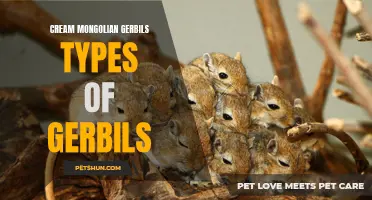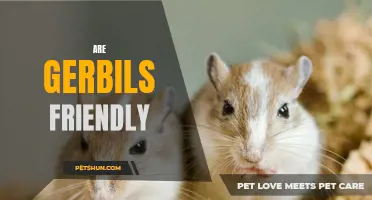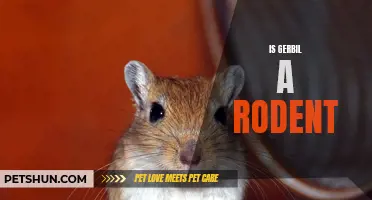
Mongolian gerbils, also known as Mongolian jirds, are fascinating little creatures that exhibit unique and intriguing behaviors. These small rodents, native to the deserts of Mongolia and China, have adapted to harsh environments and have developed a range of behaviors that help them survive and thrive. From their burrowing habits to their cooperative social structures, Mongolian gerbils offer a captivating glimpse into the intricacies of animal behavior. In this article, we will explore some of the most interesting and distinctive behaviors exhibited by these charming rodents.
| Characteristics | Values |
|---|---|
| Social behavior | Group-living, with a dominance hierarchy and cooperative breeding system |
| Activity pattern | Primarily diurnal, with increased activity at dawn and dusk |
| Habitat preference | Arid and semi-arid regions, including deserts, grasslands, and scrublands |
| Home range size | Typically around 10-50 square meters |
| Feeding behavior | Omnivorous, with a diet consisting of seeds, grains, insects, and vegetation |
| Burrowing behavior | Dig extensive burrow systems for shelter and nesting |
| Reproductive behavior | Monogamous mating pairs, with the male being highly involved in offspring care |
| Communication | Use a variety of vocalizations, body postures, and scent marking |
| Territorial behavior | Defend their burrow systems and surrounding areas from intruders |
| Aggression | Rarely display aggressive behavior towards conspecifics except during territorial disputes |
What You'll Learn
- What are some common behaviors exhibited by Mongolian gerbils in captivity?
- How do Mongolian gerbils communicate with each other?
- What factors influence the social behavior of Mongolian gerbils?
- How do Mongolian gerbils establish dominance within their groups?
- Are there any specific behaviors that are unique to Mongolian gerbils compared to other gerbil species?

What are some common behaviors exhibited by Mongolian gerbils in captivity?
Mongolian gerbils, also known as desert gerbils, are small rodents that have become popular pets because of their friendly nature and unique behaviors. While these gerbils are native to the deserts of Mongolia and China, they have adapted well to life in captivity. Understanding the common behaviors exhibited by Mongolian gerbils can help pet owners provide a stimulating and comfortable environment for their furry friends.
- Burrowing and digging: Mongolian gerbils are natural diggers and burrowers. In the wild, they create extensive underground tunnels and chambers for shelter and protection. In captivity, they will exhibit similar digging behavior by creating burrows in their cages. Providing your gerbil with a deep layer of bedding material like wood shavings or hay can satisfy their natural burrowing instincts.
- Chewing: Gerbils have constantly growing teeth, and they need to chew on objects to keep their teeth worn down. In captivity, gerbils will chew on anything they can find, including cage bars, toys, and even themselves. To prevent your gerbil from damaging their enclosure or injuring themselves, provide them with a variety of chew toys, such as wooden blocks or untreated, non-toxic branches.
- Grooming: Mongolian gerbils spend a significant amount of time grooming themselves. They use their paws and tongue to clean their fur and keep it tidy. However, they may also groom and nibble on their cage mates as a social behavior. This behavior helps strengthen social bonds within a group. If you have multiple gerbils, you may notice them grooming each other as a sign of affection and companionship.
- Scent-marking: Gerbils have scent glands located on the underside of their bellies. They use these glands to mark their territory and communicate with other gerbils. In captivity, you may notice your gerbil rubbing their belly against objects in their environment to leave their scent. This behavior is completely normal and serves as a form of communication and territoriality. It's important to avoid cleaning these scent-marked objects to maintain the gerbil's sense of security.
- Playfulness: Mongolian gerbils are known for their playful nature. They love to explore their surroundings, run around, and engage in various activities. Pet owners can provide a stimulating environment for gerbils by providing toys, tunnels, and exercise wheels to keep them entertained. Gerbils may also engage in play fighting with their cage mates, which is typically a harmless and enjoyable activity for them.
In conclusion, Mongolian gerbils exhibit several common behaviors in captivity that are rooted in their natural instincts. Understanding and accommodating these behaviors can greatly enhance the well-being and happiness of these small rodents. By providing them with opportunities to engage in burrowing, chewing, grooming, scent-marking, and playfulness, pet owners can ensure that their gerbils lead fulfilling lives in captivity.
All You Need to Know About Gerbil Care and Their Essential Needs
You may want to see also

How do Mongolian gerbils communicate with each other?
Mongolian gerbils, also known as Mongolian jirds, are small rodents that are native to the grassy steppes of Mongolia. These social animals communicate with each other in various ways to establish territories, bond with their families, and coordinate their activities. Understanding how gerbils communicate can give us insight into the complex social lives of these fascinating creatures.
One way that Mongolian gerbils communicate is through vocalizations. They produce a range of sounds, including chirps, squeaks, and trills, which they use to communicate with each other. For example, gerbils may emit a high-pitched, rapid trill to indicate alarm or danger in the environment. This vocalization may serve as a warning to other gerbils to stay alert and be on guard.
Another way that gerbils communicate is through scent marking. Mongolian gerbils are known to have scent glands located on their flanks, which they use to mark their territory. By rubbing their bodies against surfaces in their environment, such as rocks or vegetation, gerbils leave behind a scent that can be detected by other gerbils. This helps to establish territorial boundaries and communicate information about their presence to other gerbils in the area.
Gerbils also communicate through body language and gestures. For example, when two gerbils encounter each other, they may engage in a behavior called "boxing", where they stand on their hind legs and rapidly paw at each other. This is not an aggressive behavior, but rather a friendly interaction that helps to establish social bonds and communicate friendly intentions. Other gestures, such as grooming each other or touching noses, can also serve as non-verbal communication to reinforce social bonds and maintain group cohesion.
In addition to vocalizations, scent marking, and body language, gerbils also communicate through tactile signals. When gerbils groom each other, they are not only maintaining their fur and hygiene but also strengthening social bonds. Through grooming, gerbils signal trust and acceptance within their social group. This tactile communication is an important aspect of their social structure and helps them maintain strong relationships within their family units.
Overall, Mongolian gerbils have a diverse range of communication methods at their disposal. Through vocalizations, scent marking, body language, and tactile signals, they are able to coordinate their activities, establish territories, and form strong social bonds. By studying and understanding these communication methods, we can gain deeper insight into the complex social lives of these fascinating rodents.
Understanding the Natural Habitat of Gerbils: A Comprehensive Guide
You may want to see also

What factors influence the social behavior of Mongolian gerbils?
Mongolian gerbils are small rodents that are native to Mongolia and parts of China. They are known for their social behavior, which includes group living, communication, and cooperation. In this article, we will explore the factors that influence the social behavior of Mongolian gerbils.
- Group dynamics: Mongolian gerbils typically live in groups of 2-5 individuals, with a dominant male and several females. The dominance hierarchy within the group is established through aggressive interactions among individuals. The dominant male has priority access to food, mates, and preferred sleeping areas. Other individuals in the group show submission behaviors to the dominant male.
- Territoriality: Mongolian gerbils are highly territorial animals. They mark their territories using scent glands located on their belly and cheeks. The size of the territory depends on the availability of resources such as food, water, and suitable burrows. The territorial boundaries are often defended vigorously against intruders. In situations where resources are scarce, competition among groups may lead to aggression and conflicts.
- Communication: Mongolian gerbils use various forms of communication to interact with each other. They emit vocalizations such as chirps, squeaks, and squeals to signal danger, mating opportunities, or social interactions. They also use scent marking to convey information about their presence and hierarchical status. Visual cues such as body postures and tail movements are also important in social interactions.
- Reproduction: Reproduction plays a significant role in the social behavior of Mongolian gerbils. Mating occurs throughout the year, but the dominant male has priority access to the females. Female gerbils have an estrous cycle, during which they are receptive to mating for a short period. After mating, the female gives birth to a litter of 2-8 pups. The dominant male may help in raising the offspring by providing protection and sharing food with the female.
- Environmental factors: The social behavior of Mongolian gerbils can be influenced by environmental factors such as population density, resource availability, and predation pressure. In high-density populations, competition for resources may increase, leading to more aggressive behaviors and territorial disputes. Similarly, the presence of predators can affect the social dynamics of gerbil groups, as individuals need to coordinate their activities to minimize the risk of predation.
In conclusion, the social behavior of Mongolian gerbils is shaped by a variety of factors including group dynamics, territoriality, communication, reproduction, and environmental factors. Understanding these factors is essential for studying the social behavior of gerbils and provides insights into the complex social lives of these fascinating rodents.
Understanding the Genetics of the Mongolian Gerbil: A Comprehensive Study
You may want to see also

How do Mongolian gerbils establish dominance within their groups?
Mongolian gerbils, also known as Mongolian jirds or Meriones unguiculatus, are small rodents native to the arid regions of Mongolia and China. These social animals live in groups, called colonies, and within these colonies, a hierarchy is established to maintain order and prevent conflicts. The dominance hierarchy in Mongolian gerbils can be complex and dynamic, with individuals constantly vying for status within the group. In this article, we will explore how Mongolian gerbils establish dominance and the behaviors they use to establish their rank.
To understand how dominance is established, it is important to first understand the social structure of Mongolian gerbil colonies. A typical colony consists of an alpha male, an alpha female, and their offspring. These dominant individuals hold the highest rank within the group and have access to the best resources, such as food and mates. Below the alpha pair, there is a hierarchy of subordinates, with each individual having a specific rank within the group.
Dominance in Mongolian gerbils is primarily established through aggressive behaviors. When a new gerbil enters a colony, it often goes through a period of social integration, where it must establish its rank within the group. Initially, the new gerbil will be seen as a threat by the established members of the colony, and there will be tensions and conflicts as they sort out their social position.
The dominant gerbils will exhibit several behaviors to assert their dominance. These behaviors include chasing, biting, and territorial marking. This aggressive behavior serves to intimidate the lower-ranking gerbils and establish the dominance of the alpha pair. The dominant gerbils will also engage in scent marking to communicate their status to other colony members. They may urinate or rub their scent glands on objects within their territory to leave their scent, signaling their ownership and status.
Subordinate gerbils, on the other hand, will display submissive behaviors. These behaviors include crouching, making themselves appear smaller, and avoiding eye contact with the dominant gerbils. Subordinates will also show deference by allowing the dominant gerbils to have priority access to food and other resources.
It is worth noting that dominance is not fixed, and the hierarchy within a gerbil colony can change over time. New individuals may challenge the existing dominant gerbils, and if successful, they may assume a higher rank within the group. Additionally, individuals within the colony may engage in social grooming and other affiliative behaviors to solidify their social bonds and maintain harmony within the group.
In summary, Mongolian gerbils establish dominance within their groups through aggressive behaviors such as chasing, biting, and territorial marking. The dominant gerbils assert their status by intimidating and subduing lower-ranking individuals. Conversely, subordinate gerbils display submissive behaviors and deference to the dominant gerbils. The hierarchy within a gerbil colony is not fixed and can change over time through challenges from new individuals or the establishment of social bonds among colony members. Understanding the dynamics of dominance in Mongolian gerbils provides insights into their social structure and behavior, furthering our understanding of these fascinating creatures.
The Fascinating World of Female Gerbils: Everything You Need to Know
You may want to see also

Are there any specific behaviors that are unique to Mongolian gerbils compared to other gerbil species?
Gerbils are small, burrowing rodents that are popular pets due to their social behaviors and playful nature. While there are many different species of gerbils, the Mongolian gerbil (Meriones unguiculatus) is one of the most common and well-known. The Mongolian gerbil has several unique behaviors that set it apart from other gerbil species.
One of the most distinctive behaviors of Mongolian gerbils is their sand bathing ritual. Unlike many other small animals that groom themselves by licking their fur, Mongolian gerbils prefer to use sand to clean their coats. They will roll around in a shallow dish filled with sand, covering their bodies with the fine particles. This not only helps to remove dirt and oils from their fur but also provides stimulation and entertainment for the animals.
In addition to sand bathing, Mongolian gerbils are also known for their digging behavior. They have strong forelimbs and sharp claws that are well-adapted for digging tunnels and burrows. This behavior is not unique to Mongolian gerbils, as many other species of gerbils also exhibit digging behavior. However, Mongolian gerbils are particularly adept at digging complex tunnel systems that can extend several feet underground. This behavior allows them to create safe and secure nests and also helps to control their body temperature by escaping the heat of the surface during the day.
Another unique behavior of Mongolian gerbils is their vocalizations. While all gerbils can communicate through a series of vocalizations, Mongolian gerbils have a wide range of sounds that they use to communicate with each other. These include chirps, squeaks, purrs, and even howls. Each vocalization has a specific meaning and is used to convey social information such as aggression, mating readiness, or calling for help. Observing the vocalizations of Mongolian gerbils can give insight into their social dynamics and help identify potential stress or health issues.
The social behavior of Mongolian gerbils is also worth mentioning. Unlike other gerbil species that are primarily solitary, Mongolian gerbils are social animals that live in family groups. They are highly interactive with each other and engage in grooming, playing, and sleeping together. This social behavior is an important factor to consider when deciding to keep Mongolian gerbils as pets, as they thrive when they have the company of other gerbils.
In conclusion, Mongolian gerbils have several unique behaviors that distinguish them from other gerbil species. These include sand bathing, digging tunnels, a wide range of vocalizations, and a social nature. Understanding and appreciating these behaviors can help gerbil owners provide enriching and stimulating environments for their pets and ensure their well-being and happiness.
Exploring the Lifespan of Gerbils: How Long Do They Really Live?
You may want to see also
Frequently asked questions
Gerbils have constantly growing teeth, so chewing on objects helps them wear down their teeth and keep them at a healthy length. Providing your gerbil with chew toys and wood blocks can help satisfy their natural chewing instincts and prevent them from damaging other items in your home.
Gerbils are natural burrowers and burrowing is an essential behavior for them. It provides them with a sense of security, a place to rest, and a way to regulate their body temperature. Providing plenty of bedding material, such as paper-based bedding or aspen shavings, will allow your gerbil to engage in their natural burrowing behavior.
Grooming is an important behavior for gerbils to maintain their cleanliness and hygiene. By grooming themselves, gerbils remove dirt, dust, and parasites from their fur. It also helps them regulate their body temperature and keep their coat in good condition. If your gerbil is grooming excessively or has patches of fur missing, it could be a sign of stress or a health issue, and a veterinarian should be consulted.
Gerbils have a behavior known as "drumming," where they rapidly flick their hind legs against the ground, bedding, or objects. This behavior is a form of communication and is used to indicate excitement, warning, or as a territorial display. It is a normal behavior for gerbils and is not usually a cause for concern.
Gerbils make various vocalizations, such as squeaking, chirping, or purring, to communicate with other gerbils or signal their emotions. Squeaking can indicate fear, pain, or stress, while chirping can be a sign of contentment or excitement. If your gerbil is making loud, continuous, or unusual noises, it is important to observe their behavior and environment to determine if there is any underlying issue that needs to be addressed.







